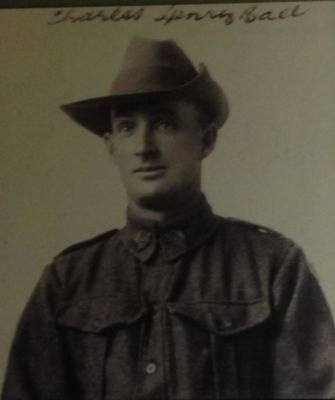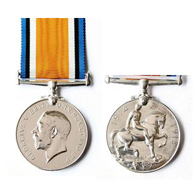BALL Charles Henry
-

- 5753
- Private
- 12th Reinforcements, 4th Pioneers Battalion ; Graves Registration Detachment
- Eumundi
- Yes
- 10 March 1885
- Eumundi Queensland
- 10 May 1917
- HMAT Osterley
- 8 May 1918
- Sydney
-
The township of Eumundi came into being in 1891 with the construction of the railway line between Cooroy and Yandina. It’s main industry was timber getting and in its heyday the town boasted two saw mills. Charles Henry Ball was born in Eumundi on 17 March, 1885, to Thomas John Ball and Harriet Ball (nee Brown). Thomas Ball was one of the pioneer settlers in Eumundi. In 1882 he selected 1,520 acres of land and grew sugar cane after clearing the land of much of the rainforest. He also established a dairy farm on the property and called it “Kauri”.
As a young man Charles remained in Eumundi and made his living as a timber getter. The surrounding country consisted of dense scrub full of pine, beech and cedar trees and long ridges covered with tallowood and blackbutt. George Etheridge, in 1895, moved his sawmill from Petrie's Creek (Nambour) to Main Camp (just north of Eumundi) and in 1900 moved it once again to Eumundi. On 18 March, 1914 Charles married Florence Jane Neil and it was a great occasion as described in the Brisbane Courier on 25 March, 1914:
“Ball – Neil
The Eumundi Methodist Church was the scene of a very pretty wedding on Wednesday last (wrote our Eumundi correspondent under date March 20), when Mr Charles Henry Ball (eldest son of Mr & Mrs T J Ball, Eloola, Eumundi, was married to Miss Florence Jane Neil (eldest daughter Mr J Neil, station master, Eumundi, and Mrs Neil). Girl friends of the bride had decorated the church with palms, pot plants, and flowers, and a floral bell was suspended above the altar. As the bride entered the church with her father, who subsequently gave her away, the congregation sang “The voice that breathed o’er Eden”. The Rev C.T. Palethorpe officiated. The bride wore a handsome gown of beautifully embossed white voile, the bodice being trimmed with kiltings of fine lace and allover guipure, and finished with white silk sash and brilliant buckle. She also wore a wreath and veil, and carried a real Maltese lace handerchief (The work of her aunt, Mrs Trundle), and wore a gold amethyst brooch (a gift from the bridegroom). A bouquet of roses, lilies, tuberoses, and asparagus plumosus completed the toilette.
Miss A. Schofield (Brisbane) acted as chief bridesmaid, and wore a cream paillette silk dress with folded sash of ninon and pearl trimming, and a hat of cream brocaded velvet with Lancer plume. Miss A. Neil (sister), who also acted as bridesmaid, wore a cream figured crystalline frock, the Magyar bodice being trimmed with cream guipure and crystal buttons, and a hat of cream, chiffon with silk flowers. Both maids carried bouquets of dahlias, chrysanthemums, caladuns, and asparagus plumosus with streamers of pink and white ribbon. The chief bridesmaid wore a gold amethyst brooch, and the second a cable brooch (gifts from the bridegroom). Mr E Baines (Mount Cooroy) acted as best man and Mr R. Hall (Brisbane) as groomsman. At the conclusion of the ceremony the bride was presented by the Rev Palethorpe with a morocco-bound volume of “Wesley’s Hymns and Tunes” on behalf of the members of the church in recognition of her services as organist. This being the first marriage in the church, the bride and bridegroom were presented with a beautiful Bible on behalf of the trustees. The newly-wedded couple left the church to the strains of Mendelssohn’s “Wedding March”, with Miss Miller presiding at the organ. The wedding breakfast was held in the School of Arts Hall, a feature of the bride’s table being a handsome three tier wedding cake. Mr and Mrs Ball left by the afternoon train for Tweed Heads for the honeymoon. Mrs Ball wore a frock of navy Dolienne silk, with Oriental trimmings and embossed lace, and a hat of cream with ostrich plumes. Many beautiful and useful presents were received, including several cheques.”
Charles did not join the stampede to enlist in the early part of the war as he was a married man with two children. However he travelled to Brisbane and enlisted on 10 May, 1917 in the 12th Reinforcements of the 4th Pioneers. At the time, he was 32 years of age weighing 154 lbs (70 kgs) and standing 6’0” (182 cms) tall. He had dark brown hair and grey eyes. He commenced his training at the Rifle Range Camp, Enoggera, Brisbane.
Pioneer Battalions were essentially light military combat engineers organised like the infantry and located at the very forward edge of the battle area. They were used to develop and enhance protection and mobility for supported troops and to deny it to the enemy. They constructed defensive positions, command posts and dugouts, prepared barbed wire defences and, on occasion, breached those of the enemy. Their skills and capability were broad; from building, construction and maintenance to road and track preparation and maintenance. They could also, and did quite often, fight as infantry.
Charles requested and received two days leave plus two days travelling time to return to Eumundi to finally arrange business details in connection with his farm. He was sent to Liverpool, Sydney for further technical training in January, 1918 and embarked on the “Osterley” on 8 May for England, arriving at Liverpool on 10 July where he proceeded to the Australian Pioneer Training Battalion at Sutton Veny. Fortunately for Charles he was not transferred to France until after the armistice and took no part in the hostilities. He left Southampton on 28 January, 1919 for Havre, France and then to his unit in the field. On the 25th March, 1919 he was seconded to the Graves Registration Detachment in France.
Sixty thousand Australians were killed in the First World War. Some were buried far from their homeland, in places that most families could barely imagine, let alone ever visit. Thousands were afforded no grave at all: modern warfare simply obliterated their bodies. It was realised early on in the war that the bodies of the dead would not be returned to Australia. One third of the Australian dead were never found. Of the bodies that were found, only one in five could be identified. For a decade after the war, Grave Registration units scoured the battlefields, exhuming the dead and searching for the missing. As late as 1921, hundreds of bodies were being found every week.
The American journalist F.H. Simonds described the battlefields in France as ‘far more terrifying and terrible’ after the war, with ‘hundreds and thousands of square miles covered by the blight of war’. Deceptively, flowers quickly grew over the battlefields after the shelling ceased. However, for the military detachments on grave duty, it was said that the thicker the flowers in an area, the more horrible it was underfoot. The soundtrack to this work was the frequent explosions of unexploded ordinance. A Court of Inquiry in 1920 found that the AIF Grave Registration Units were frequently (if not invariably) drunk, inefficient, ill-disciplined and habituated to vice. This is no surprise really, given the circumstances of their work and this can be seen in Charles’ service records when he was convicted on 8 July, 1919 of the crime of “disobeying a lawful command given by his superior officer. He forfeited two days pay.
He was recalled from France and was granted three weeks leave as all members of the Graves Registration Detachment received. From there he was transferred to the Australian Staging Camp at Sutton Veny on 22 August, 1918. Charles returned to Sydney on board the “Devonport” on 25 September, 1919 and was discharged from the army with no disabilities on 17 November, 1919.
On his return he continued to farm his “Kauri” property where he grew bananas and had cattle. He attended Progress Meetings once a month and would arrive at the meeting by horseback from the Range. Another child had been born in 1918, named Charles. These children, riding horses down the Range, went to Eumundi State School. Charles was a Councillor in 1936 – 1946. Charles and Florence continued to live on Kauri with their children until each married. The couple retired to Nambour and they died in the 1955-56 period.
-

- "Port Denison" 25th September 1919 disembarking 17th November 1919
- 1955
- Queensland, Australia
- 70
-
Eumundi & District Roll of Honour Board, Eumundi Memorial School of Arts Hall, Memorial Drive, Eumundi
Maroochy Shire Honor Roll, Shire Chambers, Bury Street, Nambour
Nambour (Maroochy Shire) Roll of Honor Scroll, Private Collection, Nambour (this scroll was available for sale to the public after the war)(on twice - as CH Ball and C Ball)
-
http://www.experienceeumundi.com.au/about-eumundi
Family History (Heading Family) - http://trees.ancestry.com.au/tree/48454041/person/20115141339?ssrc=
Wedding article - http://trove.nla.gov.au/ndp/del/article/19938886
Timber history - http://en.wikipedia.org/wiki/Eumundi,_Queensland
Service Records - http://recordsearch.naa.gov.au/scripts/Imagine.asp?B=3047032
Pioneer Battalions - http://www.rslvirtualwarmemorial.org.au/explore/units/29
Graves Registration Detachment: http://fffaif.org.au/?page_id=126
Service Records - National Archives of AustraliaImage Sources:
Colour Patch - http://www.rslvirtualwarmemorial.org.au/explore/units/29
Grave Registration Detachment at mass grave - http://www.awm.gov.au/collection/P04541.001
Grave Registration Detachment digging graves at Villers-Brettonneux area - http://www.awm.gov.au/collection E05494/ Eumundi Methodist Church - http://trove.nla.gov.au/work/191349627
Ball family - Discover Eumundi (Historical Society)Picnic in the scrub after felling of the big Kauri Pine on Charles Ball's property "Kauri" 1912
Sherwood Eversley Hull (lad) (2nd Row) Jack Ring (dark shirt) Edwin Ball, Fred Arundell (tie) Mr Mills (Bank Manager in leggings) Mrs Munro Hull, Miss Elanor Trundle, Ball Sisters (hat & scarf) (3rd row) Mr E T Ball (white beard) Helen Hull, Mrs Fred Hull, Miss Ball, Mrs Chas Ball, Mr Chas Ball (front) George Lewis (white braces) Mr Munro Hull, Mr Fred Hull, Alan Hull (baby drinking from cup)
- Yvonne Atkinson









